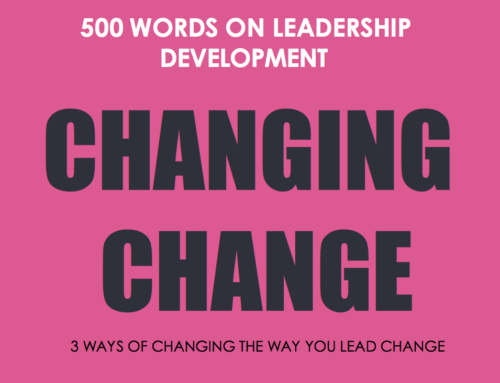Skip to content
Accelerating the Leadership of Change
“There is nothing more difficult to carry out, nor more doubtful of success, nor more dangerous to handle than to initiate a new order of things. For the reformer has enemies in all those who profit by the old order, and only lukewarm defenders by all those who could profit by the new order. This lukewarmness arises from the incredulity of mankind who do not truly believe in anything new until they have had actual experiences with it.”
—Niccolo Machiavelli, Italian historian, politician, diplomat, philosopher, writer
Leaders ask us as consultants to help them create a “new order of things.” As Machiavelli pointed out, it can be a daunting task. In this role, we travel a lot to help clients in cities around the globe. Reducing the variables of travel can make a trip easier. Consequently, we seldom take rental cars if we can avoid it. A couple of months ago, Kendall took a taxi at the hotel to travel to our client’s location just 10 minutes away. The beauty of having someone else drive is that it gives you time to reflect on the day, think through what needs to happen that morning, and arrive ready to work at the client’s site. Kendall got in the taxi, told the driver where he wanted to go, and then sat back to ruminate. After 20 minutes, Kendall pulled himself out of his reflective thoughts and suddenly wondered, “Why are we still driving?” He talked to the driver who quickly started speaking in a different language. The driver then called someone on the phone, presumably to get directions, but began yelling at whoever was on the other end of the line. Seeing the reality of the situation, Kendall asked himself, “How hard is it to figure out where you are now and then map a route to where you want to be?” In the world of instant GPS and navigational support, it shouldn’t be that hard. But as we all know, sometimes it is.
Eventually, the taxi driver found the cross-street that should have lead to the client site. But this particular street may be the only one in North America that ends abruptly in a parking garage. After negotiating with the parking attendant and emerging back onto the streets of the city, Kendall said to the driver, “Pull over.” He was done. The driver was shocked, but Kendall insisted it was time to end the ride. But this only worsened the situation because Kendall was left standing on the side of the road, in a city he didn’t know well, with no other taxis in sight.
Undaunted, Kendall set out to track down another taxi. Once again, this driver didn’t know where the client’s headquarters were (despite their being the largest employer in the city). But unlike his first taxi driver, his second one knew how to use the tools at his disposal to map the location. Finally headed in the right direction, Kendall sat in the back seat feeling upset and anxious about being late. As he calmed down and, ironically, began to mentally prepare to teach a course about change, he realized his taxi adventure was similar to how people experience and lead change.
With the accelerated pace of change today, people can feel out of control, frustrated, and anxious about what is happening in their world for several reasons. First, it feels different when we are receiving vs. leading change. When you are the recipient of change, are you confident in the “driver” of the change? Do you feel like you’ll reach your destination using the most direct route? Or is it more like Kendall’s first taxi experience—completely out of control? Does it seem like you’re being taken for a ride, and that ride will be long and expensive in many ways? Are the only options to suffer or sever?
Second, leading change can have its own challenges. How does it feel when you lead change? Are you in the driver’s seat? Have you planned an effective route to get everyone to the correct destination? Do you know how fast or slow you need to go to ensure you arrive on time? Are passengers confident in your ability and clear on where you’re going and why? In some of the change initiatives we have seen, people have told us that riding in the back seat of the change would be an improvement. Their reality is that they feel like they’re locked in the trunk getting banged up, flailing around, and getting car sick from smelling the fumes.
Many times leaders of change are like Calvin in a favorite Calvin and Hobbs cartoon. Calvin (the young adventurer) opens the scene saying to Hobbs (his imaginary friend and stuffed tiger), “I thrive on change.” To which Hobbs says, “You? You threw a fit this morning because your Mom put less jelly on your toast than yesterday!” Calvin, in dismay, says to Hobbs, “I thrive on making other people change.” In this situation, the change vehicle is actually remotely controlled! Leaders aren’t even in the car with their people. They’re dictating the change, but not embracing it themselves.
And third (just to take the metaphor a little further), who gets access to the keys of the change vehicle? As leaders receiving change from those above you, do you take ownership? Do you take the keys and get ready to drive when you receive change? Or do you point the finger up and wash your hands of all accountability? What about enabling employees to drive? Do you give them the keys to the car, but then micromanage their every move and even reach over and take the wheel when you feel they aren’t driving quite right?
Buy-in, commitment, and accountability for change is dramatically different depending on where you’re sitting in the car and if you think you have some control over the outcomes. The role of change leaders is to foster understanding, acceptance, and commitment to the change for all involved. And yet a typical approach we see is that leaders announce the change and (1) hope that people will voluntarily change, or (2) mandate the change and expect people to comply. Hoping or forcing change never works. Why? Because we are creatures of habit and are generally satisfied with the status quo—especially when a large measure of discretionary effort is required.[i]
“There is no edict in the world that will make people take risks.”
—Jack Welch, former CEO, General Electric
We see this “taxi” phenomenon play out in organizational life all the time. In a study done about the effectiveness of communication in change:[ii]
-
70% referred to their publications as “attempts at the truth” and less than 15% said that the publications reflected the entire truth.
-
64% of employees believed that management was often lying.
-
45% of employees believed that their union was usually or always telling the truth.
These numbers are fairly gloomy. Yet one finding in the study was interesting. Ninety six percent of respondents said that their supervisors were usually or always telling the truth. Why? Because these leaders are in the front seat of the change vehicle in close proximity to employees. They have a relationship of trust with their people. They know their strengths and weaknesses. They speak frankly and transparently to their team. Great leaders of change engage their people and then get out of their way. They encourage their employees to take ownership and drive the change initiative to where it ultimately needs to be.
“People are generally better persuaded by the reasons which they have themselves discovered than by those which have come into the mind of others.”
—Blaise Pascal, 17th-century French mathematician, physicist, and religious philosopher
If we revisit the quote from the beginning of the chapter, it would be easy to label Machiavelli as a change pessimist. Phrases like “nothing more difficult,” “nothing more doubtful of success,” and “nothing more dangerous” could easily discourage the most courageous of heart. Why would anybody embark on such an adventure—no matter how bright the vision of change may be? Yet careful analysis of the Italian politician’s insights could also yield a less pessimistic and a more realistic view of change. Yes, it’s hard; there are enemies to change; and it’s going to take effort to overcome the “lukewarmness” of the status quo. But the real secret to change comes from doing the hard things, not just the easy, fast, or short-term things.
[i] Phillip Ash, “Fast and Effective Change Management,” ADP Knowledge Solutions, December 2009, edition 70
[ii] T.J. Larkin and Sandar Larkin, “Reaching and Changing Frontline Employees,” Harvard Business Review, May-June 1996, p.95-104
Page load link



